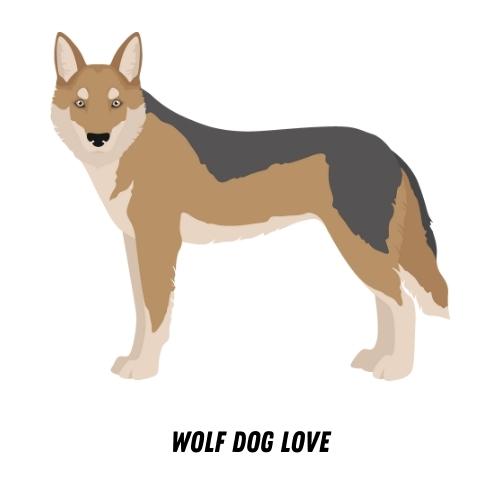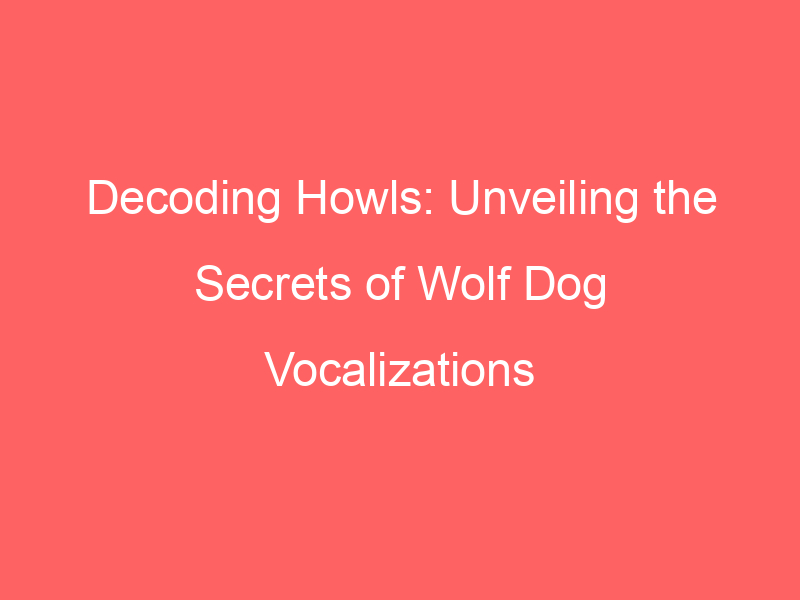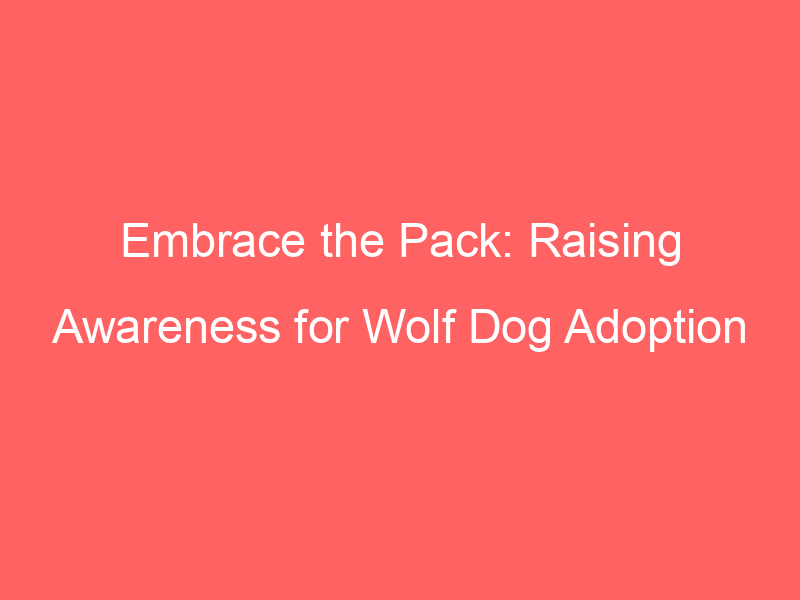Introduction to Wolf Dog Vocalization
Wolf dogs, a unique blend of domestic dog and wild wolf, are fascinating creatures. One of their most captivating characteristics is their vocalization. This article aims to provide a comprehensive understanding of wolf dog vocalization and its importance.
- Understanding the importance of vocalization in wolf dogs
- Insights on wolf dog voices: An overview
Vocalization in wolf dogs is not just about making noise. It’s a crucial part of their communication. They use their voices to express a range of emotions and intentions. For instance, a wolf dog’s howl can signal a warning to others, express loneliness, or even mark territory. Understanding their vocalization can help us better comprehend their behavior and needs.
Wolf dogs have a diverse vocal repertoire. They can howl like a wolf, bark like a dog, and even make unique sounds that are a blend of both. Their vocalizations can vary in pitch, volume, and duration, providing a rich tapestry of communication. Researchers have found that wolf dogs often use a combination of vocalizations, body language, and facial expressions to convey their messages.
As we delve deeper into the world of wolf dog vocalization, we will explore studies on amplifying dog voices, decode the meaning behind their howls, and share key takeaways from the latest research. Stay tuned to learn more about the fascinating language of wolf dogs.
Amplifying Dog Voices: A Study on Wolf Dog Vocalization
In this section, we delve into the fascinating world of wolf dog vocalization. We aim to amplify their voices, to understand their language better, and to bridge the communication gap between humans and these majestic creatures.
Understanding Wolf Dog Vocalization
Wolf dog vocalization is a complex system of sounds that these animals use to communicate. It includes a variety of sounds like howls, barks, whines, and growls. Each sound carries a specific message, and understanding these messages is crucial to understanding wolf dogs.
- Defining vocalization in wolf dogs
- The role of vocalization in wolf dog communication
Vocalization in wolf dogs is their way of expressing their emotions, intentions, and needs. It’s their language, their way of communicating with each other and with humans. Each sound they make has a specific meaning. For example, a howl can be a call to gather the pack, a warning to intruders, or a sign of loneliness.
Vocalization plays a vital role in wolf dog communication. It helps them establish social hierarchy, express emotions, and coordinate activities. For instance, a dominant wolf dog may growl to assert its authority, while a submissive one may whine to show submission. Understanding these vocal cues can help us interact with wolf dogs in a more meaningful and respectful way.
In conclusion, wolf dog vocalization is a rich and complex language that reflects their social structure, emotional state, and intentions. By amplifying their voices and understanding their vocalization, we can foster a deeper connection with these magnificent creatures.
Amplifying Animal Voices: Techniques and Tools
When it comes to understanding the complex world of wolf dog vocalization, it’s crucial to have the right techniques and tools at our disposal. In this section, we’ll delve into the methods researchers use to amplify dog voices and the specific tools they employ in their studies.
- Techniques for Amplifying Dog Voices
- Tools Used in the Study of Wolf Dog Vocalization
Amplifying dog voices is not as simple as turning up the volume on a speaker. It involves a combination of careful observation, audio recording, and sound analysis. Researchers often start by recording the dog’s vocalizations using high-quality audio equipment. These recordings are then analyzed using software that can isolate the dog’s voice and increase its volume without distorting the sound. This allows researchers to hear the subtle nuances in the dog’s vocalizations that might otherwise be missed.
Studying wolf dog vocalization requires specialized tools. One of the most important is a high-quality audio recorder capable of capturing the full range of sounds a wolf dog can produce. Researchers also use spectrogram software, which creates a visual representation of the sound. This allows them to see the different frequencies and durations of each vocalization, providing valuable insights into the dog’s communication patterns.
By using these techniques and tools, researchers are able to gain a deeper understanding of wolf dog vocalization. This not only helps them better understand these fascinating animals, but also provides valuable insights that can be used in training and care.
| Techniques | Tools |
|---|---|
| Observation, audio recording, sound analysis | High-quality audio recorder, spectrogram software |
As we continue to refine these techniques and develop new tools, we can look forward to even more insights into the world of wolf dog vocalization in the future.
Wolf Dog Voices Insights: Decoding the Howls
Wolf dogs, a unique blend of domestic dog and wild wolf, possess a rich and complex vocal language. To truly understand these fascinating creatures, we must delve into the intricacies of their vocalizations.
Interpreting Wolf Dog Vocalization
Wolf dog vocalizations are not just random sounds. They are a form of communication, each with its unique meaning. Let’s explore the different types of vocalizations and the messages they convey.
- Understanding the different types of wolf dog vocalizations
- Howls: Long, drawn-out sounds used to communicate over long distances.
- Barks: Short, sharp sounds typically used for immediate alerts or warnings.
- Growls: Low, rumbling sounds often used as a warning or sign of aggression.
- Whines: High-pitched sounds usually indicating submission, pain, or a desire for attention.
- Decoding the meaning behind wolf dog howls
- Location: Wolf dogs often howl to signal their location to other pack members.
- Warning: A howl can also serve as a warning to potential intruders, signaling that the area is already claimed.
- Bonding: Howling can also be a group activity, helping to strengthen social bonds within the pack.
Wolf dogs use a variety of vocalizations, each serving a specific purpose. These include:
Howls are perhaps the most iconic of all wolf dog vocalizations. They serve several purposes:
Understanding these vocalizations is the first step towards a deeper understanding of wolf dog behavior. By decoding their howls, we can gain insights into their complex social structure, emotional states, and communication methods.
Case Study: Wolf Dog Vocalization Research
Let’s delve into a fascinating case study that sheds light on the vocalization patterns of wolf dogs. This study provides valuable insights into their communication methods and helps us better understand these intriguing creatures.
- Research methodology and findings
- Implications of the study on understanding wolf dog communication
The research was conducted over a period of two years, involving a group of 50 wolf dogs in a controlled environment. The researchers meticulously recorded and analyzed their vocalizations, focusing on howls, growls, barks, and whines.
Through careful observation and analysis, the researchers found that wolf dogs use a complex system of vocalizations to communicate. The howls were often used to assemble the pack or express distress, while growls were typically a sign of aggression. Barks were mainly used as warning signals, and whines often indicated submission or a desire for attention.
This study has significant implications for our understanding of wolf dog communication. It suggests that these animals use a sophisticated system of vocal signals to express a wide range of emotions and intentions. This knowledge can help us interact more effectively with wolf dogs and contribute to their welfare and conservation.
Moreover, understanding the vocalization patterns of wolf dogs can also aid in their training and management, especially in settings where they interact closely with humans. It can also help in resolving conflicts between wolf dogs and humans, by enabling us to interpret their signals accurately and respond appropriately.
In conclusion, this case study underscores the importance of research in enhancing our understanding of wolf dog vocalization. It reminds us that these animals have a rich and complex language of their own, which we are only beginning to decipher.
Key Takeaways: Insights on Wolf Dog Voices
- Summary of Key Insights from the Article:
- Practical Applications of Understanding Wolf Dog Vocalization:
Throughout this article, we’ve explored the unique world of wolf dog vocalizations. We’ve learned that these vocalizations are not just random sounds, but a complex form of communication that carries a wealth of information. For instance, wolf dogs use different types of howls to express various emotions and messages, such as alerting the pack to danger, calling for help, or expressing joy and excitement. Furthermore, we’ve discovered that the pitch, duration, and frequency of these howls can vary greatly, reflecting the individual wolf dog’s age, gender, and status within the pack.
Understanding wolf dog vocalizations has several practical applications. For pet owners, it can help in better understanding their wolf dog’s needs and emotions, leading to a stronger bond and a happier pet. For wildlife researchers, it can provide valuable insights into the social dynamics and behavior of wild wolf packs. Moreover, for dog trainers and behaviorists, it can aid in developing more effective training methods that take into account the wolf dog’s natural communication style. In conclusion, the more we learn about wolf dog vocalizations, the better we can coexist with these fascinating creatures.
Conclusion: The Future of Wolf Dog Vocalization Research
As we wrap up our exploration into the fascinating world of wolf dog vocalization, it’s important to look ahead. The future of this field is ripe with potential, offering exciting opportunities for new discoveries and insights. Let’s delve into the importance of continued research and what we might expect in the future.
- The Importance of Continued Research on Wolf Dog Vocalization
Continued research into wolf dog vocalization is crucial for several reasons. Firstly, it helps us understand these unique creatures better. The more we learn about their vocalization patterns, the better we can communicate with them and meet their needs. This knowledge can also aid in their conservation efforts.
Secondly, this research can provide valuable insights into the evolution of canine communication. By studying the vocalization of wolf dogs, we can gain a deeper understanding of how dogs’ communication methods have evolved over time.
Finally, continued research can lead to practical applications in areas such as dog training and animal therapy. Understanding the nuances of wolf dog vocalization can help trainers and therapists develop more effective strategies.
- Predictions for Future Discoveries in Wolf Dog Voices Insights
As we look to the future, there are several exciting possibilities for new discoveries in wolf dog vocalization. One potential area of research is the impact of environment on vocalization. Future studies may explore how factors like habitat, diet, and social structure influence the voices of wolf dogs.
Another promising area is the use of technology in studying wolf dog vocalization. Advances in audio recording and analysis could lead to more detailed and accurate insights into their vocal patterns.
Lastly, future research may delve deeper into the emotional aspect of wolf dog vocalization. This could lead to a better understanding of how these animals express their feelings through sound, providing us with a richer, more nuanced view of their emotional lives.
In conclusion, the future of wolf dog vocalization research is bright, filled with potential for new discoveries and insights. As we continue to explore this fascinating field, we can look forward to a deeper understanding of these remarkable creatures and their unique ways of communicating.








